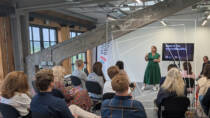8 things you probably didn’t know we do (some may surprise you)
By Sally Pritchett
CEO
We do more than strategic campaigns – here are eight ways we add unexpected value.
Our expertise is wide, and it often surprises people how much we do beyond delivering effective and inclusive creative communications. Here are eight areas where we add value in different, and sometimes unexpected, ways:
1. Naming
We create names with strategic clarity and long-term value. From naming strategies to creative options, we ensure names are credible, ownable and compelling. Whether it’s a new product, service or transformation project, names might seem like small details – but they play a big role in positioning and impact.
2. SharePoint
When employees can’t find what they need, productivity takes a hit. We design better SharePoint user experiences, making navigation clearer and information easier to access.
3. eLearning
We design and build eLearning modules, and output SCORM files, so you can bring more creativity to your team learning.
4. Gamification
From quizzes and competitions to interactive tools, we create gamified content that both informs and inspires employees – helping them engage with information in a memorable way.
5. Stakeholder management
We support leaders and comms teams to navigate complex stakeholder conversations, with practical advice and hands-on support when it’s needed most.
6. Strategic partnerships
Not ready to write a brief? We can act as a thinking partner, co-creating plans and shaping clear, effective briefs.
7. In-house team personal development
From creative inspiration sessions to proven systems that keep everything on track, we can share our experience built from over 25 years running a creative service, helping in-house teams to grow their capability and confidence.
8. Building better business cases
Budgets are harder than ever to secure. Using behavioural psychology techniques, we can help you build stronger business cases that shift the focus from cost to value.
Join our Building Better Business Cases masterclass on 23 October. Exclusive to Builder tier and above Work Wonders members. Find out more about membership here.
How we can work together
We partner flexibly, adapting to what you need:
- Activator – Got a story to tell? We simplify complex ideas and shape campaigns that bring everyone with you. Book a call
- Pathfinder – Need direction but limited budget? Join our Work Wonders community for guides, tools and events. Join Work Wonders
- Co-creator – Need a fresh perspective? We work alongside you to bring energy and insight. Talk to us
Is your impact report telling the right story for your charity?
By Sally Pritchett
CEO
If your impact report doesn’t connect with your audience, you’re missing the chance to build trust and support.
Annual impact reports are meant to show progress, inspire trust and make the case for continued support. But too often, they turn into a long list of activities – everything you’ve done, said or funded – without focusing on what really matters: what changed, and for who?
If you’re in charge of your charity’s yearly impact report, you already know the pressure. Multiple audiences. Competing priorities. A year’s worth of achievements. And just enough time to gather, write, design and publish. It’s no wonder so many reports end up as busy PDFs that few people truly engage with.
But a list of good things done isn’t the same as a story well told.
Data doesn’t speak for itself – but great report design can bring it to life
Strong report design helps visualise the numbers and pair them with human stories, so readers quickly see why your work matters.
Across the year, your charity might have delivered 36 workshops, supported 2,400 service users and trained 112 volunteers. But readers don’t just want to know the output. They want context, connection and a clear sense of how those activities made a difference.
That means:
- Highlighting the outcomes that matter most
- Pairing data or statistics with real human stories
- Stripping back anything that takes away from the story you want to tell
Put simply: don’t make people work to find the so what?
See your report as a communication tool
At its best, your impact report is an invitation for readers to better understand your mission, see the difference you’re making and feel part of the journey. It builds trust with funders, shows accountability to your community and helps stakeholders feel confident in where you’re headed.
That takes more than strong writing. Your report needs a structure that flows, visual hierarchy and inclusive, accessible language. A tone that’s confident but relatable. And a design that doesn’t just look good but also guides the reader through your achievements of the previous year.
When it’s done well, your impact report can:
- Strengthen future funding bids
- Unite teams around a shared purpose
- Turn complex work into compelling public stories
- Become something your CEO shares with pride – not just signs off
So how do you get there?
It starts by asking one simple question: “What do we want people to understand, feel and do when they read this report?” And then shaping the report around that – from the structure and copy to the design and visuals.
At Something Big, we help charities turn reports into stories worth telling. Whether you need help crafting the narrative, developing a meaningful visual concept or designing something people want to read, we’re here to help. Let’s talk about your next impact report.
Stop asking for budget – start showing the cost of doing nothing
By Sally Pritchett
CEO
The real question isn’t about the price of investing in culture – it’s about the cost of ignoring it.
You’ve spotted the signs. Motivation is low, good people are leaving, energy and performance are dropping off. You know your workplace culture needs attention – but when you raise it, there’s hesitation. Other priorities take precedence. Budget feels out of reach.
It’s a common pattern. Culture work is often seen as a nice-to-have or a long-term ambition, rather than a near-term need. But the reality? Failing to act costs far more than acting early. Poor workplace culture doesn’t just cost you engagement. It quietly drains your business, through absenteeism, turnover and underperformance.
And the impact runs deeper than many leaders realise.
The hidden cost of doing nothing
When culture starts to slide, the warning signs might not be instantly visible. But they show up clearly in business outcomes. Let’s look at just a few ways poor culture hits the bottom line:
- Employee disengagement is expensive. Gallup found that only 21% of employees worldwide feel engaged at work – costing the economy $438 billion in lost productivity.
- High turnover carries direct and indirect costs. From recruitment fees and lost knowledge to onboarding processes and the knock-on effect of team instability, the costs add up fast.
- Absenteeism tends to rise when people feel disconnected, unsupported or burned out.
- Poor performance becomes harder to challenge (and harder to turn around) when people stop caring and stop contributing.
However, all of this is avoidable. But not if work culture keeps being treated as a luxury.
Reframing the budget conversation
Instead of asking, “Can I have budget for culture?”, it’s time to flip the script. Ask: “Can we afford the cost of not investing?”
It’s a simple shift that changes the focus. It reframes culture not as an add-on, but as a performance risk. A retention risk. A strategic risk that deserves the same attention as any other. And it opens the door to a better conversation about ROI, because the return on employee engagement is real.
Investing in culture pays back in loyalty, energy, innovation and productivity. It helps people perform better, stay longer and care more. And that matters, because good people are hard to keep.
Time to move from instinct to insight
If your instinct is telling you something’s not right, trust it. But instinct alone won’t get the backing you need. That’s where diagnostics like THRIVE can help.
THRIVE helps you pinpoint exactly where culture is costing you – and where to focus your efforts for maximum impact. It takes the guesswork out of culture change, giving you a clear business case.
Because culture is never neutral. It’s either working for you or against you.
Ready to turn this into action?
Learn how to build a compelling case for culture investment by joining our Work Wonders Builder tier. You’ll get access to exclusive sessions, including our upcoming Building Better Business Cases masterclass on 23 October – packed with practical advice on how to secure support and funding for culture, comms and people initiatives.
Sign up to Work Wonders Builder tier today and get the insight and tools you need to make change happen.
Explore your workplace culture with THRIVE
By Sally Pritchett
CEO
Use our six diagnostics to explore how well your workplace culture and communication are supporting your people.
Exceptional workplace cultures don’t happen by chance – they’re built through intentional, inclusive and inspiring communication.
That’s why we created THRIVE – our methodology for building fairer, healthier and happier workplaces.
It’s based on six interconnected pillars that shape the everyday employee experience – from first contact to long-term belonging:
-
Talent – Attracting, developing and retaining people through authentic, honest and engaging employer brands.
-
Human – Bringing empathy, authenticity and emotional intelligence into the heart of the workplace.
-
Roadmap – Making strategy clear and meaningful so everyone knows where they’re heading and how they contribute.
-
Inclusion – Building a sense of inclusion and belonging that enables everyone to bring their true and best selves to work.
-
Values – Helping employees understand, believe in and live your organisational values.
-
Experience – Shaping the moments that matter, from onboarding to career milestones and beyond.
Each pillar plays a unique role in how employees feel about your organisation – and how engaged, connected and motivated they are day-to-day.
Quick diagnostics for THRIVE
We’ve built six quick, practical diagnostics – one for each THRIVE pillar. Each takes just a couple of minutes and gives you tailored insight into what’s working well, where there may be gaps, and how communication can help.
-
Talent Diagnostic: Is your EVP helping you keep the talent you’ve worked hard to hire?
-
Human Diagnostic: How well are you tuning in to your workforce?
-
Roadmap Diagnostic: Is your strategy really landing with your people?
-
Inclusion Diagnostic: How inclusive and accessible are your communications?
-
Values Diagnostic: Are your organisational values being heard and lived?
-
Experience Diagnostic: How well do your communications help shape the employee experience?
Whether you take one, a few, or all six, you’ll get tailored feedback and practical next steps to help strengthen your communication and employee experience.
Because when employees feel clear, connected and supported, great cultures don’t just survive – they thrive. And if the results show opportunities to improve, we’re here to help you take the next step.
It’s time to rethink how much we’re communicating
By Sally Pritchett
CEO
We’re drowning in comms – and it’s costing us time, focus and performance.
“We’re overcommunicating ourselves into burnout and inefficiency, and it’s time to reset.”
That’s what our CEO Sally told the TEDx audience – and it’s a message every communicator should be taking seriously.
88% of our time at work is now spent communicating. We’re battling constant meetings, pinging inboxes, Slack messages stacked on WhatsApps stacked on Teams. All of it fighting for our attention – and draining the time and headspace people need to focus, think, and create.
We’ve normalised the constant noise. But it’s not harmless.
The real cost of overcommunication
We like to think communication helps productivity. But too often, it’s doing the opposite. It slows decisions. Drowns clarity. Fuels confusion, stress and burnout.
And as Sally pointed out, it’s not just the tech and tools that are to blame – it’s us. With all our hopes and hang-ups. We overcommunicate because we care. Because we’re scared. Because we want to be seen. Because we want to help. Because we want to feel useful, included, appreciated. And now we’ve started communicating in those ways, it’s become hard to stop.
Top-down decisions to tackle this by turning off channels or reducing meetings can only go so far. As communicators, we need to be making better choices too.
Communicators have a vital role to play
If you work in internal comms, this is your moment. Not to add more to the mix, but to be the one asking the hard questions:
- Does this need saying at all?
- Is this the right channel for it?
- How will this land with the people receiving it?
- Are we helping or interrupting?
Workforces need clearer purpose, more intention and more respect for the cost of their time, and attention.
Time to lead a communication reset
Sally’s TEDx talk isn’t just a reflection on where we are – it’s a call to do things differently. To stop measuring communication by volume and start focusing on impact. For those of us in comms, that means stepping up, not to add more, but to guide better. To help our organisations cut through the noise, not contribute to it.
Coming in early 2026, Sally’s new book Overloaded explores the human drivers behind today’s workplace noise and offers a practical roadmap to bring more intention to the way we communicate. Packed with stories, tools and everyday tactics, it will help teams reset their approach and communicate in ways that support focus, connection and performance. Find out more at LINK
Watch the TEDx talk here
Shaping better employee experiences through the moments that matter
By Sally Pritchett
CEO
Every employee moment is a chance to build trust, connection and clarity – if the communication is done right.
Just as you might carefully map out a customer journey, the employee experience deserves the same level of attention. From candidate to colleague, every interaction is a chance to deepen employee engagement and encourage long-term loyalty.
At the heart of a great employee experience is thoughtful, timely communication – the kind that supports the moments that matter throughout a colleague’s career. Key communication touchpoints like onboarding messages, promotion announcements, policy updates and exit communications all shape how employees feel about your organisation.
And the impact is real. Employees who report positive experiences are 16 times more engaged than those who’ve had negative ones. That engagement feeds into everything – motivation, performance, retention and ultimately, business success.
How do you make every moment count?
Whether it’s someone starting a new role, navigating a restructure or returning from parental leave, these moments call for well-considered communication. When employee comms are shaped with empathy, they do more than just share information – they help people feel supported, understood and prepared for what’s next.
At each key employee touchpoint, reflect on the following questions:
- What does someone need to know right now?
- How might they be feeling?
- What would help them feel seen, informed or supported?
It’s also important to think carefully about the format, channel and tone that will be most effective for that milestone. Sometimes it’s a personal email from a manager. Other times a short video, a drop-in Q&A or a simple checklist might land better.
Enhance your employee experience with THRIVE
We use our THRIVE methodology to help organisations build fairer, healthier and more connected workplaces through better communication. Our EXPERIENCE pillar focuses on using communication to actively shape a positive workplace experience – at every stage of the employee journey.
Want to dig a little deeper?
Try our Experience Diagnostic – a quick tool for HR, comms and leadership teams to assess what’s landing, what’s missing and where communication could work harder across the employee journey. It only takes a few minutes and gives you practical, tailored insight you can act on. Take the diagnostic.
Three ways to transform employee experiences through communication
1. Zoom in on the moments that matter
Start by mapping out the employee journey, identifying where the biggest emotional and practical touchpoints are. These could be milestone moments (like joining or leaving) or transitional ones (like changing teams or stepping into leadership). These are your high-impact touchpoints – and getting the communication right here can shape the wider employee experience.
2. Listen first, communicate after
Avoid relying on assumptions about what people need to hear. Ask them. Involve employees in shaping the messages and formats that support key moments. Use feedback to refine your approach, sense-check tone and make sure the messaging feels clear, respectful and helpful.
3. Make your communication consistent
When communication feels inconsistent, so does the employee experience. Give teams what they need to communicate key moments clearly and consistently – with toolkits, messaging frameworks and manager guides that support a joined-up experience.
Every interaction adds up. When we map these communication touchpoints across the full employee lifecycle and communicate intentionally at each point – we create a consistent, engaging employee experience.
How we help shape better employee experiences
Exceptional workplace cultures don’t happen by chance – they’re built through intentional, inclusive and inspiring communication.
We help teams:
- Bring key moments to life with campaigns, content and creative that make the employee experience feel meaningful and engaging
- Strengthen internal communication using the right mix of formats, channels and messaging to support the workforce at every stage
- Equip teams to deliver consistently with toolkits, templates and training that help comms land well across the organisation
There are three ways to work with us:
Activator – Have a story you need to tell? We help simplify complex ideas, shape strong narratives and build campaigns that bring everyone with you. Book a call to discuss your brief.
Pathfinder – Struggling for budget but need direction? Join our community of passionate changemakers and access free guides, tools and events. Sign up to join Work Wonders here.
Co-creator – Already have an in-house team or agency but need fresh thinking? Tap into our advisory services to bring in external perspective and energy. Let’s talk about your challenges, book a call here.
Why tuning in is key to a more human workplace
By Sally Pritchett
CEO
To build trust and connection, organisations need to listen in more human ways.
Many organisations say they’re listening. But true employee listening means more than sending out pulse surveys or inviting questions at a town hall. Teams want to feel heard and to see that their feedback leads to meaningful action.
When that doesn’t happen, people question whether their input was ever meant to make a difference – and stop speaking up. In fact, 41% of employees have left a job because they felt their feedback wasn’t valued (Exploding Topics, 2024). A lack of visible follow-up doesn’t just affect future engagement – it can undermine trust, increase resistance to change and impact retention.
That’s why ‘tuning in’ matters. It’s not just listening – it’s showing people they’ve been heard, acting on what they’ve said and communicating in ways that reflect their reality. And when organisations take that approach, they create workplaces where people feel safe to speak up and are more invested in the business’ success.
Stop broadcasting, start tuning in
A truly human workplace doesn’t just broadcast out to people – it listens to them. ‘Tuning in’ is the opposite of broadcasting. It’s about listening first, responding with consideration and using communication in ways that help the workforce feel seen, heard and involved.
When organisations rely on one-way updates or generic messaging, people feel overlooked. But when communication is shaped by what employees are experiencing – their concerns, ideas and questions – it starts to build trust. It shows that feedback isn’t just collected, it’s taken seriously.
And the impact is real. Employees who feel their opinions are heard are 4.6 times more likely to feel empowered to perform at their best (Salesforce, 2023). Over time, ‘tuning in’ helps build the psychological safety that leads to better performance, stronger loyalty and openness to change.
Three ways to ‘tune in’ to your workforce
1. Close the loop
Gathering feedback is just the starting point. What matters next is showing employees that their input has been acknowledged and is leading to meaningful action. Create listening loops that go beyond surveys – through manager check-ins, team conversations and business follow-ups. And be transparent, even if the answer is “not yet.”
2. Reflect reality in your tone of voice
Messaging that sugarcoats or ignores what people are experiencing can quickly erode trust. Communication should reflect what employees are feeling, not just what the business wants to say. When your tone and messaging are shaped by real employee insight, it shows you’re listening. Speak in human, inclusive language, and be clear about what you know and what you’re still working out.
3. Make managers part of the conversation
Managers play a vital role in helping people feel heard and can help keep your listening strategy alive. Support them with the tools to unpack what feedback really means, explain outcomes and continue conversations in a way that feels thoughtful and human.
Building human-centred cultures with THRIVE
We use our THRIVE methodology to help organisations build fairer, healthier and more connected workplaces through improved communication. One of our six pillars is HUMAN – focused on what it really means to ‘tune in’ to your people.
That starts with hearing what employees are really saying and understanding what they need. It means recognising people not just for what they do, but for who they are – their roles, life stages, backgrounds and individual needs. It’s about creating a culture where colleagues feel seen, supported and safe to speak up.
Want to dig a little deeper?
Try our Human Diagnostic – a quick tool for HR, comms and leadership teams who want to check how well they’re really tuning in to their people. It only takes a few minutes and gives you practical insights to strengthen trust, connection and culture. Take the diagnostic.
How we support a human approach to employee listening
Exceptional workplace cultures don’t happen by chance – they’re built through intentional, inclusive and insight-led communication. We help teams:
- Shape language, tone and listening strategy
From tone of voice guidance to comms planning, we help you build the foundations for more human, responsive communication. - Bring campaigns to life with authentic employee storytelling
We support creative concepting, campaign activation and comms that put employee voices at the heart of the message. - Support manager comms, feedback loops and wellbeing-led engagement
From toolkits and talking points to insightful video learning, we help managers communicate with clarity and confidence – and keep listening going beyond an annual survey.
‘Tuning in’ isn’t a one-off exercise – it’s a shift in how organisations listen to and communicate with their workforces. Because when employees feel heard, they’re more likely to stay, contribute and thrive.
Here are three ways to work with us:
Activator – Have a story you need to tell? We help simplify complex ideas, shape strong narratives and build campaigns that bring everyone with you. Book a call to discuss your brief.
Pathfinder – Struggling for budget but need direction? Join our community of passionate changemakers and access free guides, tools and events. Sign up to join Work Wonders here.
Co-creator – Already have an in-house team or agency but need fresh thinking? Tap into our advisory services to bring in external perspective and energy. Let’s talk about your challenges, book a call here.
Why an authentic employer brand is a powerful talent retention tool
By Sally Pritchett
CEO
If what you promise new hires doesn’t match what they experience, they won’t stick around.
Most organisations don’t set out to mislead people. But when what’s promised to potential hires doesn’t match what they actually experience, it can leave new joiners can feeling let down.
That’s why authenticity matters. A bold, well-branded employee value proposition (EVP) might help you attract talent. But it’s your employer brand – how that promise is consistently lived and felt day to day – that helps ensure people stay.
An EVP is the promise you make to employees and candidates about what it’s like to work with you – and the value they’ll get in return. It only works if it matches reality.
The recruitment process went smoothly. The interviews felt aligned. But just a few months in, and you find out your new hire is already moving on. Sound familiar?
You’re not alone. In fact, ThriveMap found that 48% of employees have left a role because the reality didn’t match how it was communicated to them. That gap isn’t usually intentional – it’s often a sign that the business has changed, but the employer brand hasn’t kept up.
And when lived experience doesn’t match the promise, employee engagement drops – and the talent you worked hard to hire becomes hard to retain.
Your EVP is the promise. Your employer brand is how that promise is expressed and experienced – both inside and outside the organisation.
A strong employer brand is grounded in real employee experience
This is where the EVP and employer brand need to work together. It’s about making sure your EVP reflects the reality of working in your organisation – from recruitment through to development and beyond. For example, if your EVP promises flexibility, that needs to be genuinely felt and truly reflected in the everyday company culture – not just written in policy.
When the message matches what’s experienced, it builds trust, shows care and progress, and gives people the confidence that they’re in the right place.
This is where communication really comes into play. An EVP isn’t a one-off statement. It needs to be reflected through the moments that matter in the employee experience:
- Job adverts and interviews
- Onboarding and welcome materials
- Internal storytelling and recognition
- Team meetings and leadership updates
- Change announcements and exit conversations
Employer brand can’t be a one-off project
We’d never treat a customer brand as a one-off campaign – so why do we still do it with employer brands? While customer messaging is constantly refined to reflect changing expectations, EVP and employer brand work is too often treated as a one-time project or initiative.
But people change. Cultures evolve. New leadership comes in. If your employer brand doesn’t keep pace with shifts in your culture and employee experience, it stops doing its job effectively.
So, how do you keep things aligned? Here are three practical ways to keep your EVP and employer brand stay believable:
1. Activate what’s already true
If your EVP still reflects who you are, bring it to life. Use communications to tell real stories, involve your people in the narrative and make it visible to incoming talent.
2. Use insights to close the gap
Ask employees what they’re hearing, feeling and experiencing. Use insights from listening sessions, engagement surveys and exit interviews to spot where the message and reality don’t align.
3. Rebuild if you need to
If your business has changed significantly, it might be time to revisit your EVP. Co-creating a new one with your people makes it stronger – and ensures your employer brand reflects what you’re offering and what’s real.
Bringing your employer brand to life – and keeping it alive
Communication connects people to your culture, your brand and their experience from day one. And that communication needs to make sense for your employees – storytelling people relate to, language that lands and messaging that reflects who you really are.
That’s where we come in.
We use our THRIVE methodology to help organisations build fairer, healthier and happier workplaces through improved communication. One of our six pillars is Talent – focused on how people connect with your EVP, engage with your employer brand and experience your culture at every stage of the employee journey.
Want to dig a little deeper?
Try our Talent Diagnostic – a quick tool for HR, comms and leadership teams to discover how well your EVP and employee experience are aligned, and how that’s impacting your ability to retain talent. Take the diagnostic.
Retention starts with a promise you can keep
A strong EVP gives new employees something to believe in. A clear, consistent employer brand helps them see it in action. When the two are aligned – and grounded in authenticity – employees don’t just stay. They grow, contribute and thrive.
Exceptional workplace cultures aren’t built on buzzwords – they’re built on communication that connects.
We help teams:
- Explore the reality of the employee experience through research, listening and insight
- Shape and sharpen EVPs to reflect the culture people are experiencing
- Build employer brand campaigns that attract and retain the right talent
- Keep them alive through storytelling, leadership comms and everyday touchpoints
Here are three ways to work with us:
Activator – Have a story you need to tell? We help simplify complex ideas, shape strong narratives and build campaigns that bring everyone with you. Book a call to discuss your brief.
Pathfinder – Struggling for budget but need direction? Join our community of passionate changemakers and access free guides, tools and events. Sign up to join Work Wonders here.
Co-creator – Already have an in-house team or agency but need fresh thinking? Tap into our advisory services to bring in external perspective and energy. Let’s talk about your challenges, book a call here.
How can your people perform at their best if communication isn’t inclusive?
By Sally Pritchett
CEO
Inclusion isn’t an add-on. It’s a business-critical part of how we communicate, lead and perform.
Everyone has the right to be seen, heard, valued and respected at work. Things like gender, ethnicity, religion, sexual orientation, age or other characteristics should not negatively affect how someone is treated. There is a clear ethical obligation to create a workplace where everyone is treated with fairness and respect – but there’s a strong commercial case too:
- Forbes reports that employees who feel they belong are up to 3.5 times more likely to bring their full potential to work – with even greater impact for under- and misrepresented groups.
- CIPHR Forester backs this up, identifying belonging as a performance driver. 80% of those who feel they belong report higher motivation, leading to a 56% increase in job performance.
- Mercer finds that employees who can bring their authentic selves to work are twice as likely to trust their organisation and five times more likely to be satisfied with no intent to leave.
Even with all the evidence behind it, inclusion and belonging still aren’t the reality for everyone. Around 1 in 4 employees say they don’t feel they belong. This is a gap we believe better communication can help close – starting with a few key areas:
Get set for success
How an employee feels when they join a company can set the tone for how welcome they feel. According to HR Magazine, just 76% of black and Asian employees feel welcomed when they join, in comparison to the significantly higher 85% of white employees. Reviewing your onboarding processes could surface opportunities for improvement.
Giving employees a voice
According to the Edelman Trust Barometer, a quarter of employees feel they don’t have a voice within their organisation. From employee satisfaction or pulse surveys to listening groups, employee forums, ERGs and taskforces, there are many ways to help shift from one-way dialogue to two-way communication.
Ensuring communication is inclusive, accessible and authentic
Whether it’s reviewing language use, font choice, colour contrasts or ensuring there are adequate channels that reach everyone in the organisation, there are so many small but intentional actions organisations can take. Sometimes simple word selection like replacing lunch break with rest break to acknowledging nightshifts or removing unnecessarily gendered references in policies or communication can make employees feel more seen and valued. You can check out our guide to help you here.
Raising awareness and building better allyship
Belonging isn’t universal. When people don’t feel welcomed, it not only affects their engagement but their confidence and ability to contribute. It’s important to acknowledge employees from under and misrepresented communities have a different experience of work. Whether it’s the way they access meaningful work or their everyday experience at work there are big equity gaps. Leading campaigns to educate and raise awareness of active allyship can make a huge difference to colleague support, psychological safety levels and reduced microaggressions and bias. Check out this campaign we developed for one of our clients to foster belonging.
Want to dig a bit deeper?
Take our Inclusion Diagnostic – built for internal communicators who want to check how inclusive their communications are and where there are opportunities for improvement. It only takes a couple of minutes and gives you tailored insight with practical next steps. Take the diagnostic.
Need to build a more inclusive workplace where employees can feel they belong?
We see the impact of clear, inclusive communication every day through our THRIVE methodology – a practical framework that helps organisations build fairer, healthier and happier workplaces. One of its six pillars is Inclusion, focused on helping employees feel genuinely valued and respected. If you’re working to strengthen inclusion and belonging in your organisation, THRIVE is a great place to start.
Exceptional workplace cultures don’t happen by chance, they’re built through intentional, inclusive and inspiring communication.
We can help you:
- Simplify and articulate your existing values in a way that helps everyone understand the expectations on them
- Launch or re-launch your values in a way that brings fresh energy, engagement and alignment
- Keep your values alive through behaviour change, leadership alignment and consistent, embedded communication
There’s no one-size-fits-all when it comes to fostering inclusion. That’s why we offer three ways to work with us – depending on where you are now, and where you want to get to.
Activator – Have a story you need to tell? We help simplify complex ideas, shape strong narratives and build campaigns that bring everyone with you. Book a call to discuss your brief.
Pathfinder – Struggling for budget but need direction? Join our community of passionate changemakers and access free guides, tools and events. Sign up to join Work Wonders here.
Co-creator – Already have an in-house team or agency but need fresh thinking? Tap into our advisory services to bring in external perspective and energy. Let’s talk about your challenges, book a call here.
HR is under pressure – and the pressure isn’t easing. Here’s how comms can help
By Sally Pritchett
CEO
The pressure on HR is rising. Strategic communication can help carry the weight.
There’s growing pressure in HR – and it’s not easing any time soon. 64% of HR professionals say they’re experiencing near-constant stress. Budgets are tight. Workloads keep growing. And the pace of change is relentless – legislative, cultural, technological. The HR function is stretched, often seen as a cost centre rather than a strategic driver, and yet still expected to hold the organisation together.
That reality came through clearly at a recent We Do Group event, where our CEO Sally joined a room full of passionate HR leaders to talk about change, culture and communication – and how the pressure on HR is rising, even as expectations grow.
We know that HR can rise to the challenge – with communication as a strong and strategic ally.
Change is happening – whether you’re ready or not
Change is already happening – the question is whether it’s happening to you or with you. And whether it’s planned or reactive, it always ends up at HR’s door.
Right now, leaders are being asked to guide people through uncharted territory – AI, instability, uncertainty. That calls for a different kind of leadership. Not just confident decision-makers, but emotionally intelligent, authentic ones. HR has a powerful role to play in helping those leaders listen better, connect more deeply, and create the safety their people need. But HR can’t do it alone.
That’s where communication comes in – as an expert partner in guiding people through change. While the destination might stay the same, how we get there will keep shifting. Comms helps teams stay connected to the golden thread of purpose and values along the way.
Done well, communication can unite rather than divide. It can shape trust, bring clarity and give people something solid to hold onto, even when the path is uncertain.
Repositioning HR: From compliance to culture
HR needs a rebrand. It’s still too often positioned as a back-office function – focused on policy, compliance and admin. But HR is culture and separating the two no longer makes sense. Every day, we see HR teams being asked to drive culture – to lead on engagement, inclusion, wellbeing and values – without always being given the recognition, resource or influence that should come with it.
If we’re serious about people and culture being a business priority, we have to start treating it like one. That means:
- Stop reporting on outputs. Start talking about impact.
- Don’t just ask for budget – show the cost of not investing in people and culture.
- Use storytelling to land what data alone can’t.
- Move the conversation on from hybrid vs office – and focus instead on proximity, connection and leadership that truly listens.
It also means tightening the loop between HR and internal comms. Because how you say things can be just as important as what you say – especially in moments of change.
People are listening – even when you think they’re not
In a hyper-connected world, everything you say internally can and will be seen externally. Employees are customers. Suppliers are stakeholders. Very few messages stay internal these days and that makes transparency non-negotiable.
If you only communicate when things are going well, you’ll lose trust when things aren’t. Hard news doesn’t damage trust – poor communication does. When it’s time for tough decisions like redundancy during difficult economic times, your people should have already been on the journey to understand the context, not hear it for the first time on the day of an announcement.
It’s much easier to get a message right the first time than to try and rebuild trust after it’s broken.
What HR needs now
The HR function looks different in every business – but the pressure is felt everywhere. Whether you’re flying the flag for culture in the boardroom or delivering the tactical day-to-day, you deserve better tools, stronger influence and genuine partnership.
Change is happening either to you or with you. The difference often comes down to whether comms is working with HR – or working in parallel.
At Something Big, we understand HR. We know the pressure you’re under – and the passion and potential that drives you. We’re here to support you with communication that’s commercially minded, consistent and comprehensive, right when you need it most. Let’s talk about your people and culture challenges – and how we can tackle them together.
If you work in HR and you’re looking for insight, connection and fresh thinking, you’re not alone. Our Work Wonders community is built for people like you – passionate about people and culture, and ready to share ideas, challenges and support. Join us and be part of a growing network of HR and comms professionals making change happen.










